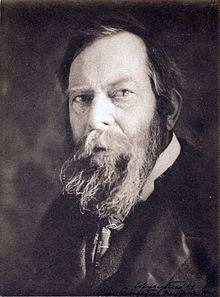Albert Pinkham Ryder
| Albert Pinkham Ryder | |
|---|---|

Ryder in 1905, photo by Alice Boughton
|
|
| Born |
March 19, 1847 New Bedford, Massachusetts |
| Died | March 28, 1917 (aged 70) New York City |
| Nationality | American |
| Education | National Academy of Design |
| Known for | Painting |
| Movement | Tonalism |
Albert Pinkham Ryder (March 19, 1847 – March 28, 1917) was an American painter best known for his poetic and moody allegorical works and seascapes, as well as his eccentric personality. While his art shared an emphasis on subtle variations of color with tonalist works of the time, it was unique for accentuating form in a way that some art historians regard as modernist.
Ryder was born in New Bedford, Massachusetts. New Bedford, a bustling whaling port during the 19th century, had an intimate connection with the sea that probably supplied artistic inspiration for Ryder later in life. He was as the youngest of four sons; little else is known of his childhood. He began to paint landscapes while in New Bedford. The Ryder family moved to New York City in 1867 or 1868 to join Ryder's elder brother, who had opened a successful restaurant. His brother also managed the Hotel Albert, which became a Greenwich Village landmark. Ryder took his meals at this hostelry for many years, but it was named for the original owner, Albert Rosenbaum, not the painter.
The early view of Ryder was that he was a recluse, holding that he developed his style in isolation and without influence from contemporary American or European art, but this view has been contradicted by later scholarship that has revealed his many associations and exposures to other artists. Ryder's first training in art was with the painter William Edgar Marshall in New York. From 1870 to 1873, and again from 1874 to 1875, Ryder studied art at the National Academy of Design. He exhibited his first painting there in 1873 and met artist Julian Alden Weir, who became his lifelong friend. In 1877, Ryder made the first of four trips to Europe throughout his life, where his studying of the paintings of the French Barbizon school and the Dutch Hague School would have a significant impact on his work. Also in 1877, he became a founding member of the Society of American Artists. The Society was a loosely organized group whose work did not conform to the academic standards of the day, and its members included Augustus Saint-Gaudens, Robert Swain Gifford (also from New Bedford), Ryder's friend Julian Alden Weir, John LaFarge, and Alexander Helwig Wyant. Ryder exhibited with this group from 1878 to 1887. His early paintings of the 1870s were often tonalist landscapes, sometimes including cattle, trees and small buildings.
...
Wikipedia
